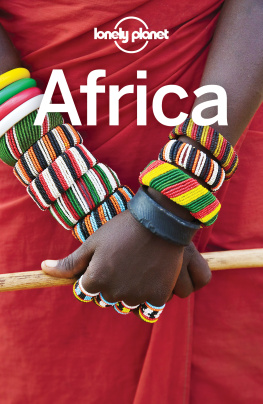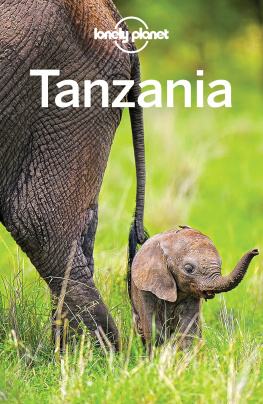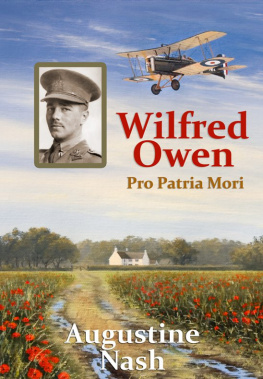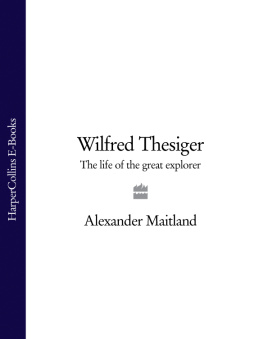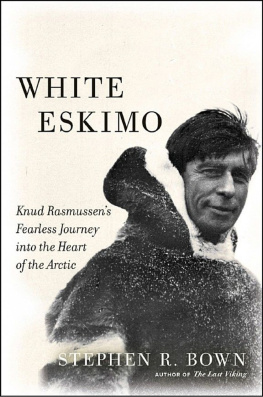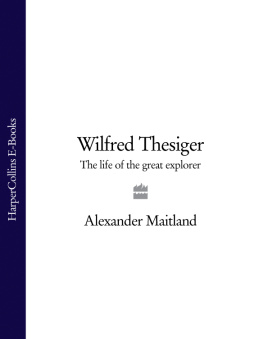WILFRED THESIGER
IN
AFRICA
EDITED BY CHRISTOPHER MORTON
AND PHILIP N. GROVER
Published to accompany
Wilfred Thesiger in Africa: A Centenary Exhibition,
Pitt Rivers Museum

Contents
Chapter 1
Wilfred Thesiger in Africa
A LEXANDER M AITLAND
The greatest traveller of the twentieth century and one of its greatest explorers, Sir Wilfred Thesiger is most famous for his journeys in Arabia and his sojourns among the Marsh Arabs in Iraq. Yet fifty of Thesigers seventy years living, travelling and exploring in remote places were spent in East and North Africa. Thesiger was born in 1910 at Addis Ababa and lived there until 1919 when his family returned to England. Throughout his life, Thesiger continued to revisit Ethiopia, which he preferred to call by its former name Abyssinia. In 1944 he achieved his boyhood ambition of living and working in Ethiopia; however, this was in wartime when he felt that he might have been employed more usefully elsewhere. From 1960 to 1963 and from 1968 to 1977 he travelled each year, on foot, using camels to carry baggage, in northern Kenya. From 1978 to 1994, he settled at Maralal in Kenyas Eastern Rift Valley Province, among the cattle-owning Samburu. It was there, among his Samburu and Turkana adoptive families, that he wished to spend his final years.
From 1919 to 1933 Thesiger was educated in England, first at St Aubyns preparatory school in East Sussex, and later at Eton College, followed by Magdalen College, Oxford, where he read Modern History. Thesigers 1930 autumn term at Oxford was interrupted by Haile Selassies coronation, to which he was invited both by the Emperor himself and the Foreign Office as Honorary Attach to HRH the Duke of Gloucester, who headed the British Mission.
Dressed in a morning suit that contrasted dully with the dress uniforms and medals worn by others in the Duke of Gloucesters party, Thesiger felt conspicuous and ill at ease. Soon, however, he was absorbed by the splendours of the occasion and wrote: You could easily imagine yourself back in the days of Sheba.
After the ceremonies were over, Thesiger set off alone to hunt big game, following the Awash River as far as the hot springs at Bilen. Looking back, he felt convinced that this month in a country inhabited by the Afar (Danakil) He described this journey in the first chapter of Arabian Sands(1959):
My first night in camp, as I sat eating sardines out of a tin and watching my Somalis driving the camels up from the river to couch them by the tent, I knew that I would not have been anywhere else for all the money in the world. For a month I travelled in an arid hostile land. I was alone; there was no one whom I could consult; if I met with trouble from the tribes I could get no help; if I were sick there was no one to doctor me. Men trusted me and obeyed my orders; I was responsible for their safety. I was often tired and thirsty, sometimes frightened and lonely, but I tasted freedom and a way of life from which there could be no recall.
The opportunity of hunting and travelling in Abyssinia had given Thesiger a tremendous thrill. His family ties with the country dated from 1868 when his grandfather, the Hon. Frederic Augustus Thesiger, had served as Deputy Adjutant-General under Sir Robert Napier during the campaign to release a British consul and other captives imprisoned at Meqdala (Magdala) in Abyssinia by the increasingly harsh and erratic Emperor Tewodros (Theodore) II. As General Lord Chelmsford, Frederic Thesiger later commanded the British force in South Africa, in 1879, during the Xhosa and Zulu Wars. Although he finally defeated the Zulu army at the battle of Ulundi, Chelmsford would be remembered not for this crucial victory, but for the massacre of more than 1,300 of his troops by the Zulu army at Isandhlwana. At Wilfred Thesigers home in the Welsh borders were the assegais, clubs and shields that his grandfather had brought back from Zululand. Memories of conflicting emotions stirred by the Zulu relics caused Thesiger to write in The Life of My Choice(1987): my grandfather had shattered the Zulu army at Ulundi but I never begrudged those peerless warriors their earlier, annihilating victory over a British force on the slopes of Isandhlwana.
Abyssinian impressions
Thesigers father, Wilfred Gilbert Thesiger, died in 1920. The third son of Lord Chelmsford, he joined the consular service in 1895, and was posted first of all to Lake Van in eastern Turkey, followed by Taranto, in southern Italy, Belgrade, and then St Petersburg. In 1907 he was posted to Boma in the eastern Congo. In Belgrade he proved his ability and courage by running single-handed the British Legation, after anarchists had murdered King Alexander and Queen Draga. In the Congo, Wilfred Gilbert investigated Sir Roger Casements shocking reports of atrocities inflicted by Belgian officials on native workers employed in the plantations. He performed these duties so efficiently that, in 1909, he was appointed HM Consul-General and Minister Plenipotentiary in charge of the British Legation at Addis Ababa, which his immediate predecessor, Captain John Harrington, had helped to establish only a few years before the Thesigers arrival there.
On 21 August 1909, Captain the Honourable Wilfred Gilbert Thesiger DSO married Kathleen Mary Vigors at St Peters Church, Belgrave Square, London. The couple arrived at Addis Ababa in early December, after they had trekked for a month with mules, across the Tchercher Mountains, from the railhead at Dire Dawa in eastern Abyssinia. Wilfred Patrick, eldest of the Thesigers four sons, was born at 8 p.m. on Friday 3 June 1910 in one of the circular, thatched mud huts known as tukuls,which originally housed the British Legation. These huts were less primitive than Thesigers descriptions suggest. The better furnishings were shipped from England, and then transported by camel-caravan across the Danakil Desert. The wattle-and-daub walls of the Thesigers tukulwere tastefully papered and decorated with framed pictures, and the exposed roof lathes were interlaced with coloured ribbons. Kathleen Thesiger thought them enchanting and described the Legation tukulsas wonderfully spacious and most comfortable to live in. The single-storey building housing the new Legation had a pedimented faade and shuttered windows. Sited in a compound that according to Kathleen was the size of St Jamess Park in London, it was completed in 1911, and became the familys home for the next eight years. Thesigers parents were both energetic gardeners and the gardens they laid out and planted have remained to this day very much as they left them.
Thesigers early upbringing in Addis Ababa was immensely significant, and, he maintained, affected the whole course of his life from then on. His brother Brian, a year younger, who joined in everything Wilfred did, remained almost untouched by their shared experiences. The two youngest children, Dermot and Roderic, were aged 5 and 3 when the Thesigers left Abyssinia early in 1919. As a result, neither the country nor its people left any lasting impression on them.
Thesiger remembered vividly sitting on the Legation steps in the evening, and listening to his father read aloud from his favourite books. Among them were Jock of the Bushveld(1907), Sir Percy Fitzpatricks story of a dogs adventures in the South African wilds; A Sporting Trip through Abyssinia(1902) by Major P. H. G. Powell-Cotton; and African Nature Notes and Reminiscences(1908) by Frederick Courteney Selous. Edmund Caldwells beautiful drawings in
Next page




